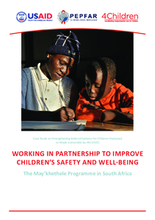Displaying 81 - 90 of 230
This article presents findings of a state-wide trauma informed child-welfare initiative with the goal of improving well-being, permanency and maltreatment outcomes for traumatized children.
Reported here are findings from a recent partnership research project focused on optimizing grandparent contact and ongoing relationships with grandchildren after child safety concerns.
This study examined the four factors that might bias child risk assessment and recommendation of treatment for children at high risk among Arab social workers in Israel.
The article examines how 36 child welfare caseworkers in 6 different teams in Norway investigate, assess, and make decisions at the phase of an incoming referral.
This Manual includes background information, standard operating procedures with documentation tools and job aids on case management.
This case study is one in a series of case studies highlighting different aspects of a case management system and referral mechanisms utilized by OVC programs. The case study looks at the work of the Children in Distress Network (CINDI) in the uMgungundlovu District of KwaZulu-Natal Province (KZN) of South Africa.
This case study is one in a series of case studies highlighting different aspects of a case management system and referral mechanisms utilized by OVC programs. The case study presents a program in Mozambique that could be identified as a hub and spoke model of referral mechanism.
This study answers the following question: “How does the case-specific context influence the practitioners' decision-making process regarding matching in family foster care?”
This brief guide from Casey Family Programs lays out strategies for recruiting and retaining tribal foster families for American Indian and Alaska Native children, ensuring that indigenous children can stay in their communities.
This study addresses three key research questions: (1) How do older youth in foster care define their personal permanency goals? (2) How much progress have these youth made in achieving their personal permanency goals and other aspects of relational permanency, and how does this vary by gender, race, and age? and (3) What transition-related outcomes are associated with relational permanency achievement?





